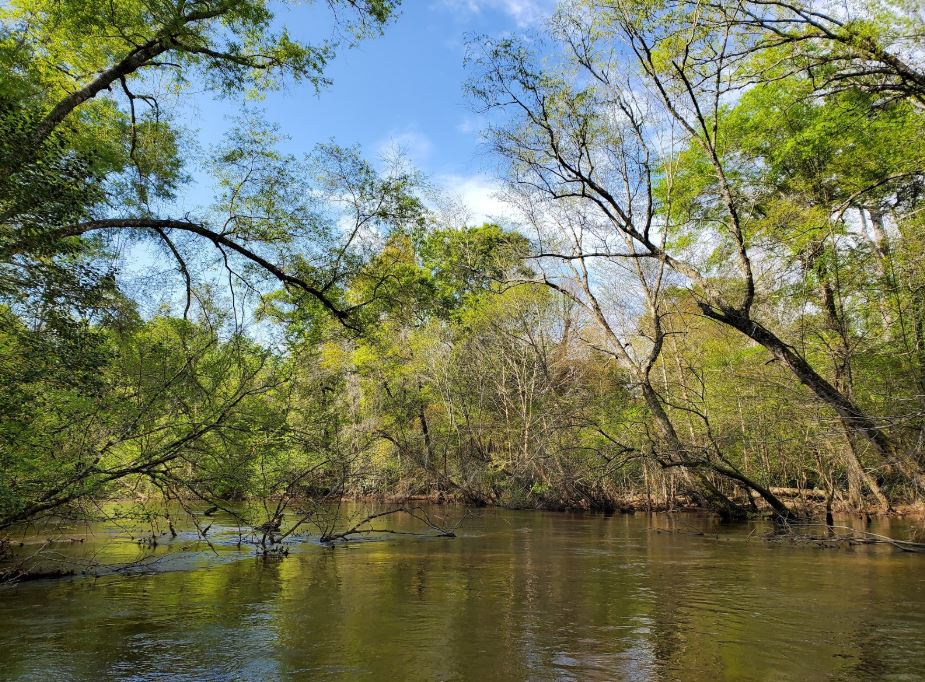By Holt Bigelow

After an entire week of being stuck in Albany, Georgia because of COVID-19, my Dad and I had had enough. On Thursday night we planned an outdoor trip for that weekend, canoeing an 8-mile stretch of Kinchafoonee Creek about an hour north of home. We had never done that stretch before and were eager to get on the water.
At 7:30 Saturday morning, my Dad and I left for Bottsford, Georgia wholly unaware of the trip we had signed ourselves up for. We took the canoe and all the gear out at the put-in site and I proceeded to take up my extremely important job of staying with the gear while my Dad drove back to the take-out site, left the car, and schlepped 10 miles back to the put-in on his bike. While he did that, I took an excellent nap.
We were on the water by 10 o’clock and by 10:02 we had encountered the first of many downed trees over the creek, each presenting a uniquely time-consuming puzzle regarding how to get past them. Strategies we employed to get past the trees were as follows: The Big Buster™ (paddle as fast as you can towards a perceived weak spot in the brush or tree), The Duck-and-Pray™ (paddle towards a high thicket, do canoe limbo, then hope you don’t eat sticks as soon as you poke your head back up), and The Up-and-Over™ (portage the canoe over a downed tree trunk, using that trunk for balance).

Making matters even more difficult was the creek’s tendency to fork out into pathways that occasionally led to gum tree swamps. Each pathway usually led back to the main creek, but taking the wrong one could add incalculable amounts of time tree-busting and swamp navigating. By the time we got off the river, it was 3 o’clock meaning that we had spent 5 hours in order to go 8 miles.
Key to my endeavors as a bowsman was the draw stroke, in which one positions their paddle parallel to the canoe and pulls water towards the canoe, causing a quick change in direction towards the paddle. I used it often to avoid unseen downed logs and other random river debris.
Other than all the trees and the various vines I clotheslined myself on, the trip was spectacular. The swamp azaleas were in full bloom and, surprisingly, March in South Georgia is quite balmy, especially when shaded by swamp willows and water oaks. Unlike many other stretches of river in Georgia, this one had virtually no trash and, given the number of downed trees, we surmised that it probably hadn’t been touched by humans in years.
The amazing thing about the trip to me was that my dad and I spent 5 hours in total on the river, none of which were occupied by thoughts or conversation about COVID-19. Personally, I was too preoccupied with the nature around me and the difficulty of the trip to let my mind fester on a virus. The quarantine and 24/7 news media have joined forces to form a Voltron that inundates us with worrying statistics, nonsense speculation, and constant coverage of a threat that feels both inevitable and all-powerful. In order to get out of the quagmire of COVID-19 coverage, sometimes it’s best to put yourself into another quagmire. So I implore anybody reading this, go outside and feel the sun burn your skin as you trek through (local) nature (at a socially safe distance from other trippers). Trust me, it’s a lot better than staying in and watching the news.
About the Author
Name: Holt Bigelow
Year in School: Freshman
Major: English
Hometown: Albany, Georgia
Favorite Outdoor Activity: Paddling
Favorite Camp Food: Refried Beans & Rice
Ideal Outdoor Trip Destination: The Amazon
If you were stranded on a desert island, what/who would you bring with you: A Guitar